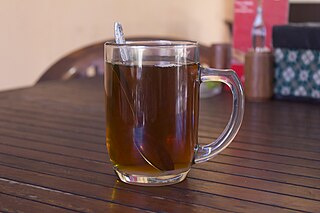
A drink or beverage is a liquid intended for human consumption. In addition to their basic function of satisfying thirst, drinks play important roles in human culture. Common types of drinks include plain drinking water, milk, juice, smoothies and soft drinks. Traditionally warm beverages include coffee, tea, and hot chocolate. Caffeinated drinks that contain the stimulant caffeine have a long history.
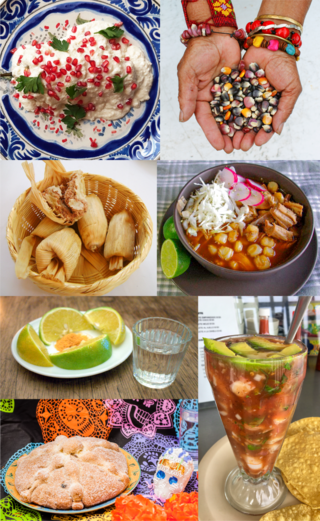
Mexican cuisine consists of the cooking cuisines and traditions of the modern country of Mexico. Its earliest roots lie in Mesoamerican cuisine. Mexican cuisine ingredients and methods begin with the first agricultural communities such as the Olmec and Maya who domesticated maize, created the standard process of nixtamalization, and established their foodways. Successive waves of other Mesoamerican groups brought with them their cooking methods. These included: the Teotihuacanos, Toltec, Huastec, Zapotec, Mixtec, Otomi, Purépecha, Totonac, Mazatec, Mazahua, and Nahua. With the Mexica formation of the multi-ethnic Triple Alliance, culinary foodways became infused.

Ginger ale is a carbonated soft drink flavoured with ginger. It is consumed on its own or used as a mixer, often with spirit-based drinks. There are two main types of ginger ale. The golden style is credited to the Irish doctor Thomas Joseph Cantrell. The dry style, a paler drink with a much milder ginger flavour, was created by Canadian John McLaughlin.

Costa Rican cuisine is known for being mostly mild, with high reliance on fruits and vegetables. Rice and black beans are a staple of most traditional Costa Rican meals, often served three times a day. Costa Rican fare is nutritionally well rounded, and nearly always cooked from scratch from fresh ingredients. Owing to the location of the country, tropical fruits and vegetables are readily available and included in the local cuisine.

Palm wine, known by several local names, is an alcoholic beverage created from the sap of various species of palm trees such as the palmyra, date palms, and coconut palms. It is known by various names in different regions and is common in various parts of Africa, the Caribbean, South America, South Asia, Southeast Asia, and Micronesia.

Chicha is a fermented (alcoholic) or non-fermented beverage of Latin America, emerging from the Andes and Amazonia regions. In both the pre- and post-Spanish conquest periods, corn beer made from a variety of maize landraces has been the most common form of chicha. However, chicha is also made from a variety of other cultigens and wild plants, including, among others, quinoa, kañiwa, peanut, manioc, palm fruit, rice, potato, oca, and chañar. There are many regional variations of chicha. In the Inca Empire, chicha had ceremonial and ritual uses.
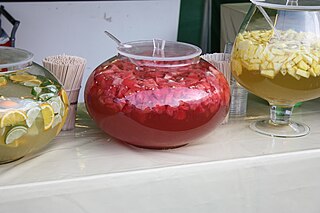
The term punch refers to a wide assortment of drinks, both non-alcoholic and alcoholic, generally containing fruits or fruit juice. The drink was introduced from the Indian subcontinent to England by employees of the East India Company in the late 17th century. Punch is usually served at parties in large, wide bowls, known as punch bowls.
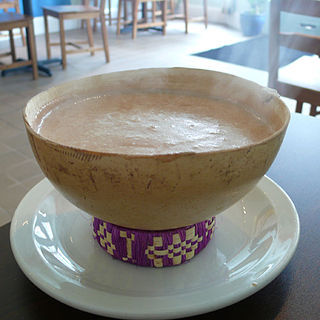
Champurrado is a chocolate-based atole, a warm and thick Mexican beverage. It is prepared with either a masa , masa harina, or corn flour ; piloncillo; water or milk; and occasionally containing cinnamon, anise seed, or vanilla. Ground nuts, orange zest, and egg can also be added to thicken and enrich the drink. Atole drinks are whipped up using a wooden whisk called a molinillo. The whisk is rolled between the palms of the hands, then moved back and forth in the mixture, until it is aerated and frothy; a blender may also be used.

History of beer in Mexico dates from the Spanish conquest of the Aztec Empire. While Mesoamerican cultures knew of fermented alcoholic beverages, including a corn beer, long before the 16th century, European style beer brewed with barley was introduced with the Spanish invasion soon after Hernán Cortés's arrival. Production of this beer here was limited during the colonial period due to the lack of materials and severe restrictions and taxes placed on the product by Spanish authorities. After the Mexican War of Independence, these restrictions disappeared, and the industry was permitted to develop. Furthermore, the arrival of German immigrants during the ephemeral Second Mexican Empire of elected Maximilian I of Mexico, born an Austrian archduke, in the 19th century provided the impetus for the opening of many breweries in various parts of the country.
Purposeful production of alcoholic drinks is common and often reflects cultural and religious peculiarities as much as geographical and sociological conditions.

Colombian cuisine is a culinary tradition of the six main regions within Colombia. Colombian cuisine varies regionally and is influenced by Indigenous Colombian, Spanish, and African cuisines, with a slight Arab influence in some regions.
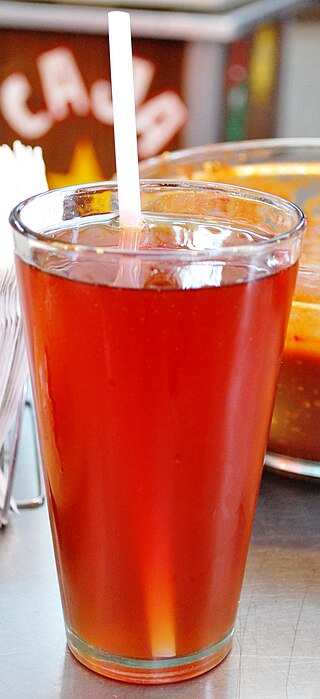
Tepache is a fermented beverage made from the peel and the rind of pineapples, and is sweetened either with piloncillo or brown sugar. It is sometimes seasoned with chili powder and served cold. Tepache is usually sold as a chilled drink by street vendors in Mexico, stored in barrels to expedite the fermentation process. It is served either in a clay mug or in a clear plastic bag with a straw inserted for easier travel. In the U.S., it is sold in juice bars or traditional Mexican restaurants within Mexican American communities of the Southwestern United States.
Tiswin is an alcoholic beverage brewed from corn. Tiswin is also the sacred saguaro wine of the Tohono O'odham, a group of aboriginal Americans who reside primarily in the Sonoran Desert of the southeastern Arizona and northwest Mexico.

Sugarcane juice is the liquid extracted from pressed sugarcane. It is consumed as a beverage in many places, especially where sugarcane is commercially grown, such as Southeast Asia, the Indian subcontinent, North Africa, mainly Egypt, and also in South America. Sugarcane juice is obtained by crushing peeled sugarcane in a mill and is one of the main precursors of rum.

Mexican street food, called antojitos, is prepared by street vendors and at small traditional markets in Mexico. Street foods include tacos, tamales, gorditas, quesadillas, empalmes, tostadas, chalupa, elote, tlayudas, cemita, pambazo, empanada, nachos, chilaquiles, fajitas, tortas, even hamburgers and hot dogs, as well as fresh fruits, vegetables, beverages and soups such as menudo, pozole and pancita. Most are available in the morning and the evening, as mid-afternoon is the time for the main formal meal of the day. Mexico has one of the most extensive street food cultures in Latin America, and Forbes named Mexico City as one of the foremost cities in the world in which to eat on the street.
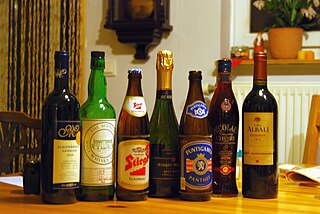
An alcoholic beverage is a beverage containing alcohol (ethanol). Alcoholic drinks are typically divided into three classes—beers, wines, and spirits—and typically their alcohol content is between 3% and 50%.

Pozol is the name of both fermented corn dough and the cocoa drink made from it, which has its origins in Pre-Columbian Mesoamerica. The drink is consumed in the south of Mexico in the states of Campeche, Chiapas, and Tabasco. It is a thirst quencher that has also been used to fight diseases. It has also aided indigenous peoples of the Americas as sustenance on long trips across the jungles.
















